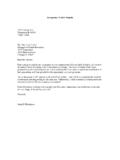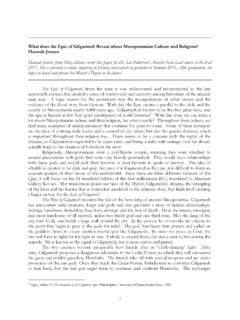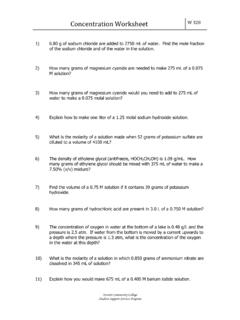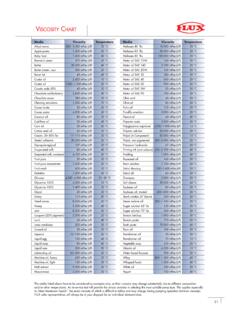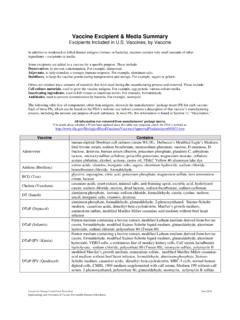Transcription of Tutorial 4 SOLUTION STOICHIOMETRY - EIU
1 T-27 Tutorial 4 SOLUTION STOICHIOMETRYS olution STOICHIOMETRY calculations involve chemical reactions taking place in the various methods of expressing SOLUTION concentration the most convenient for generallaboratory use is molarity, which is defined: Moles of solute nsoluteMolarity = or M = Liters of SOLUTION LsolnChemical reactions are written in terms of moles of reactants and products; this molarityconcentration unit relates moles of solute to volume of SOLUTION . Thus, easily measured solutionvolumes provide a simple method of measuring moles of : What is the molarity of a SOLUTION made by dissolving g of potassium chloridein enough water to make mL of SOLUTION ?This data gives a relationship between amount of solute and volume of SOLUTION : g KCl mL. To find molarity we must convert grams KCl to moles KCl and mL SOLUTION to g KCl 1 mol KCl 1000 mL mol KCl x x = or M KCl mL g KCl L LWhenever the SOLUTION concentration is given in molarity, M, you must change to the equivalentunits, mol/L or mol/1000 mL, to use as a conversion : What mass of solute is contained in mL of a M KCl SOLUTION ?
2 The conversion sequence is:mL SOLUTION L SOLUTION mol KCl g KCl 1 L mol KCl g mL x x x = g KCl 1000 mL L mol KCl T-28OR, use the conversion sequence:mL SOLUTION mol KCl g KCl mol KCl g mL x x = g KCl 1000 mL mol KCl EXAMPLE: What mass of potassium chloride would be needed to prepare mL of a SOLUTION ? 1 L mol KCl g mL x x x = g KCl (needed) 1000 mL L mol KCl OR mol KCl g mL x x = g KCl (needed) 1000 mL mol KCl Please note: the preceding two EXAMPLES are the same kind of problem worded differently: conversion from volume of SOLUTION to mass of : Silver nitrate SOLUTION is added to mL of a M potassium chloridesolution until no more precipitate forms.
3 What mass of silver chloride will be formed?The chemical equation for the reaction is:KCl (aq) + AgNO3 (aq) AgCl (s) + KNO3 (aq)Since the concentration and volume of silver nitrate SOLUTION are not specified, we can assume itis in excess. First find the number of moles of KCl in the mL of M SOLUTION : mol KCl(A) mL x = mol KCl 1000 mL T-29 From the mole ratio in the balanced chemical equation: 1 mol AgCl(B) mol KCl x = mol AgCl formed 1 mol KCl Then convert to grams of AgCl: g AgCl(C) mol AgCl x = g AgCl formed mol AgCl Steps (A), (B), and (C) may be combined: mol KCl 1 mol AgCl g mL x x x = g AgCl 1000 mL 1 mol KCl mol AgCL Please note: the steps in solving this problem are essentially the same as used in Tutorial 3.
4 The only difference is the method of first finding moles: thereafter they are identical volume and concentration of both reactant solutions are given then you are dealing with alimiting reagent problem. The first step is to find the moles of each reactant from the volumeand concentration of the SOLUTION . Once moles are found the process is the same as shown inTutorial 3, p following equations are needed for some of the problems in this (aq) + BaCl2 (aq) BaSO4 (s) + 2 NaCl (aq)BaCl2 (aq) + 2 AgNO3 (aq) 2 AgCl (s) + Ba(NO3)2 (aq)Ca(OH)2 (aq) + 2 HCl (aq) CaCl2 (aq) + 2H2O (l)2Al(OH)3 (s) + 3H2SO4 (aq) Al2(SO4)3 (aq) + 6H2O (l)AlCl3 (aq) + 3 NaOH (aq) Al(OH)3 (s) + 3 NaCl (aq)3 KOH (aq) + H3PO4 (aq) K3PO4 (aq) + 3H2O (l)T-30 1)Calculate the molarity of the following solutions : a) g of potassium chloride in mL of ) x 10 2 g of silver nitrate in mL of ) g of barium chloride in mL of ) mg of calcium hydroxide in mL of ) g of aluminum chloride in mL of ) g of potassium hydroxide in L of ) g of sodium carbonate in mL of SOLUTION .
5 H) x 10 6 kg of potassium phosphate in mL of SOLUTION . 2)What mass of solute is contained in mL of a M sodium hydroxide SOLUTION ? 3)What mass of solute is needed to prepare mL of a M potassium nitratesolution? 4)What mass of solute is contained in mL of a M barium nitrate SOLUTION ? 5)What volume of M silver nitrate contains gram of silver nitrate? 6)What volume of M aluminum chloride SOLUTION contains g of solute? 7) mL of a M sodium chloride SOLUTION was evaporated to dryness. What massof solid remained? 8)In what total volume must g of sodium nitrate be dissolved to make a Msolution? 9)Barium chloride SOLUTION is added to mL of a M sodium sulfate SOLUTION untilno more precipitate forms. What mass of barium sulfate forms?10)Excess barium chloride SOLUTION is added to mL of M silver nitrate SOLUTION . What mass of silver chloride is formed?11)What mass of aluminum hydroxide is required to completely react with mL of sulfuric acid SOLUTION ?12)Excess sodium hydroxide SOLUTION is added to mL of M aluminum chloridesolution.
6 What mass of aluminum hydroxide is formed?T-3113)What volume of M sulfuric acid is needed to dissolve g of aluminumhydroxide? What is the molarity of the resulting SOLUTION of aluminum sulfate? (Assumefinal SOLUTION volume = volume of sulfuric acid used.)14)Silver chloride is formed by mixing silver nitrate and barium chloride solutions . Whatvolume of M barium chloride SOLUTION is needed to form g of silver chloride?15)What volume of M potassium hydroxide SOLUTION is needed to react completely witha SOLUTION containing g of phosphoric acid?16)What volume of M hydrochloric acid is needed to react completely with a solutioncontaining g of calcium hydroxide ?17) mL of M barium chloride SOLUTION is mixed with mL of silvernitrate SOLUTION . What mass of silver chloride will be formed?18) mL of M barium chloride SOLUTION is mixed with mL of M silvernitrate SOLUTION . What mass of silver chloride will be formed?19) mL of M aluminum chloride SOLUTION is mixed with mL of Msodium hydroxide SOLUTION .
7 What mass of aluminum hydroxide will be formed?20) mL of a SOLUTION containing g of potassium hydroxide is mixed with mLof a M phosphoric acid SOLUTION . Will the resulting mixture be acidic or basic? Whatwill be the molarity of the potassium phosphate formed? (Assume the volumes areadditive.)21) mL of M phosphoric acid SOLUTION is titrated with M potassium hydroxidesolution. What volume of base SOLUTION is needed for complete neutralization?22) mL of a barium chloride SOLUTION is titrated with M silver nitrate SOLUTION . mL of the silver nitrate SOLUTION is required to completely precipitate the chloride ionas silver chloride. What is the molarity of the barium chloride SOLUTION ?23) mL of a phosphoric acid SOLUTION required mL of a M potassiumhydroxide SOLUTION for neutralization. What is the molarity of the acid?24) mL of a M calcium hydroxide SOLUTION is titrated with M hydrochloricacid SOLUTION . What volume of acid is needed for complete neutralization?
8 25) mL of M hydrochloric acid is titrated with a calcium hydroxide SOLUTION , and mL of the base is required for complete neutralization. What is the molarity of thecalcium hydroxide SOLUTION ?T-32 Answers to Problems 1)a) M KCl10) g AgCl b) x 10 4 M AgNO311) g Al(OH)3 c) x 10 4 M BaCl212) g Al(OH)3 d) x 10 3 M Ca(OH)213) mL H2SO4; M Al2(SO4)3 e) M AlCl314) mL BaCl2 f) M KOH15)122 mL KOH g) M Na2CO316) mL HCl h) x 10 5 M K3PO417)AgNO3 limiting; g AgCl 2) g NaOH18)BaCl2 limiting; g AgCl 3) g KNO319)NaCl limiting; g Al(OH)3 4) g Ba(NO3)220)acidic; M K3PO4 5) mL AgNO321)247 mL KOH 6)166 mL AlCl322) M BaCl2 7) g NaCl23) M H3PO4 8)235 mL24) mL HCl 9) g BaSO425) M Ca(OH)2


